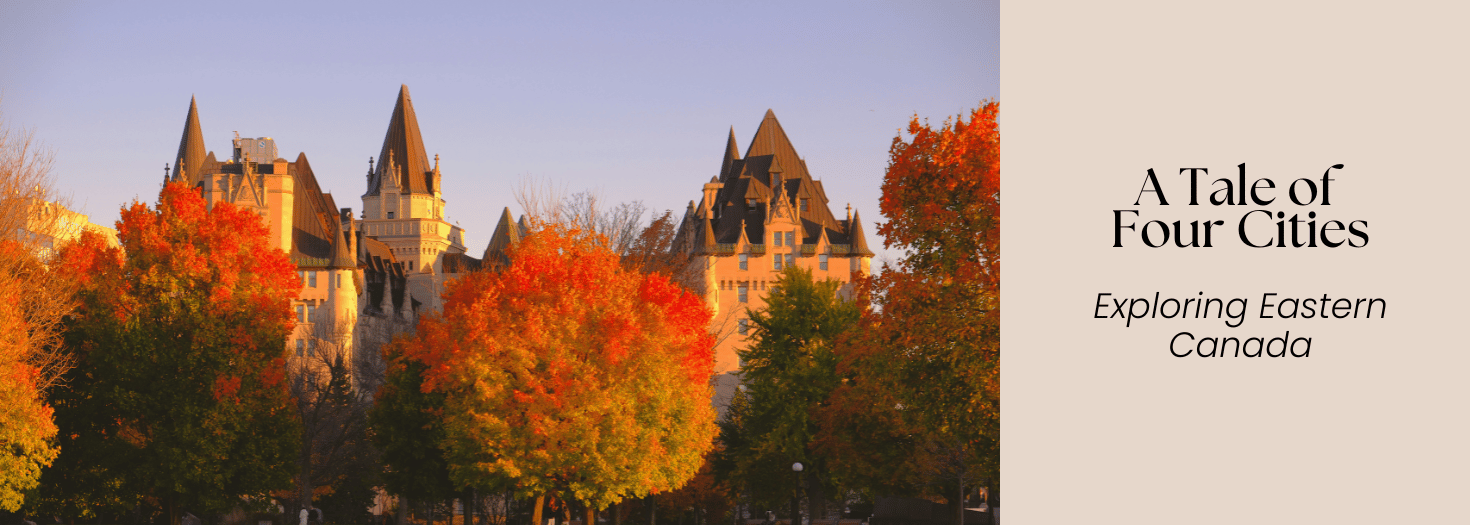Exploring Eastern Canada: A Tale of Four Cities
Table of Contents
Eastern Canada has a way of shifting gears on you. Toronto comes at you fast - all towers, restaurants, and a bit of restless energy - while Montréal is slower and softer around the edges, with French accents and late-night festivals that spill into the streets. Québec City feels like a set from another era, cobbled and turreted, while Ottawa keeps things stately with its Gothic buildings and wide-open green spaces. Travel between them and you don’t just tick off cities – you get four completely different takes on what Canada can be.
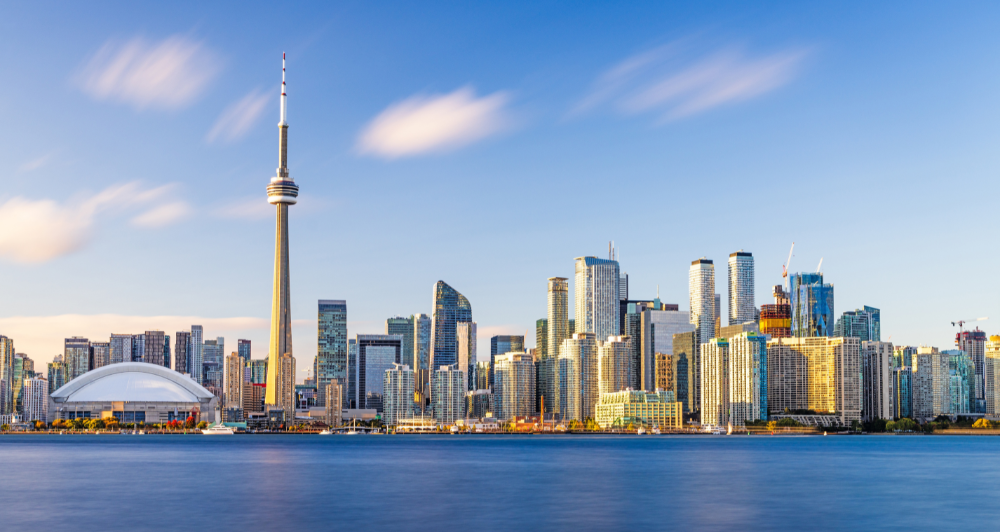
Toronto – Glass and Grit
Toronto likes to make an entrance. The skyline is alive with ambition, but scratch the surface and you’ll find there’s plenty of grit and character too. As Canada’s most populous city with over 160 languages spoken, there’s bound to be.
If it’s views you’re wanting (and it’s views we recommend), then start at the CN Tower – the views stretch across Lake Ontario and beyond. If you fancy turning sightseeing into something more decadent, book a table at the revolving 360 Restaurant at the top. It’s home to the world’s highest wine cellar, though the local craft beer “Life in the Clouds” feels perfectly on point when you’re drinking it in the sky.
Neighbourhoods are where Toronto really shows its personality, and they deserve slow exploration. Kensington Market is a riot of vintage shops, taco stands, and street art (as bohemian and eclectic as its 1960s London namesake) while the Distillery District feels like another century altogether – cobblestones and red-brick warehouses now housing galleries and cocktail bars. Then there’s Yorkville: glossy shopfronts (CHANEL, Hermès, Balenciaga), polished art galleries like Galerie De Bellefeuille, a Four Seasons hotel, and chic cafés that wouldn’t look out of place in Milan.
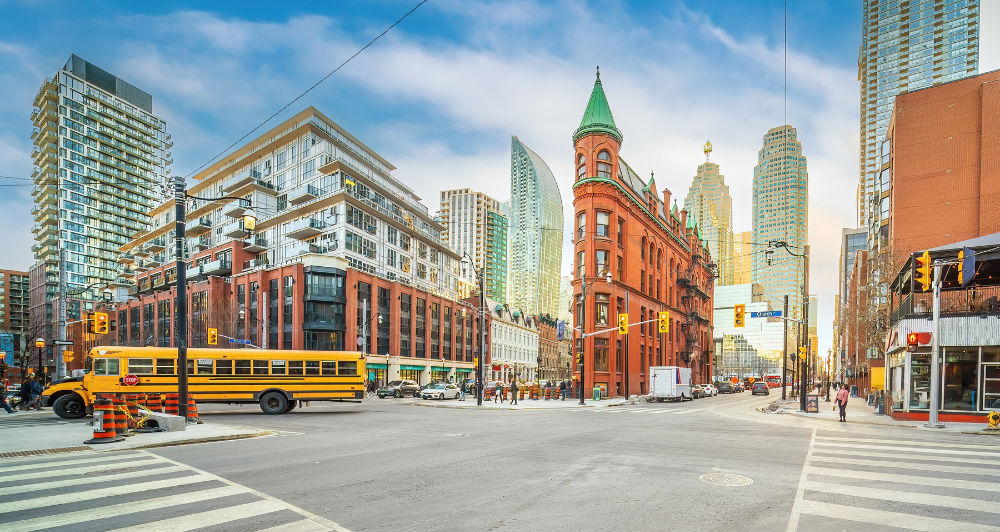
And then there’s the food. Toronto’s dining scene really is a headline in its own right. Restaurant 20 Victoria is small and moody and all about seafood. Think dim lights and inventive dishes, a short but exquisite tasting menu and the kind of details that stay with you. Alo is louder, slicker, and consistently ranked as one of Canada’s best restaurants. The multi-course menu is a surprise – served blind, so you won’t know what’s coming – but often leans into French techniques to include oysters, foie gras, maybe even some Dover sole.
If you want a big-ticket extra to balance the pace of the city, we’d suggest booking a private helicopter ride to Niagara Falls. You also have the option to add on a sommelier-led wine tasting in the Niagara Peninsula too, which makes for a very dramatic and decadent escape from the city.
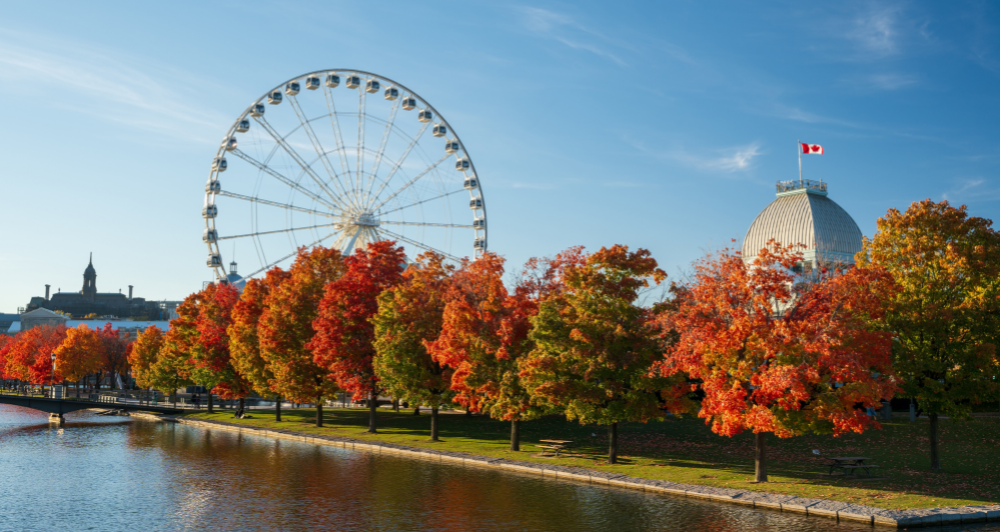
Montréal – French Flair with a Canadian Twist
If Toronto is about scale and ambition, Montréal is about mood and atmosphere. For us, this is where Canada feels most European - French voices in the air, narrow streets, centuries-old churches - but always with its own Canadian spin.
Old Montréal is the obvious first stop, a must see for any keen explorers or first timers. Its cobbled lanes and limestone façades lead you past Notre-Dame Basilica, art galleries and street performers. For a caffeine break, duck into Crew Collective & Café – a former bank turned café and co-working space. The interiors - all vaulted ceilings, intricate carvings and marble columns that feel like they’ve been lifted straight from Paris - show exactly how heritage buildings can evolve, while still harking back to a time when architecture took its inspiration from fine art.
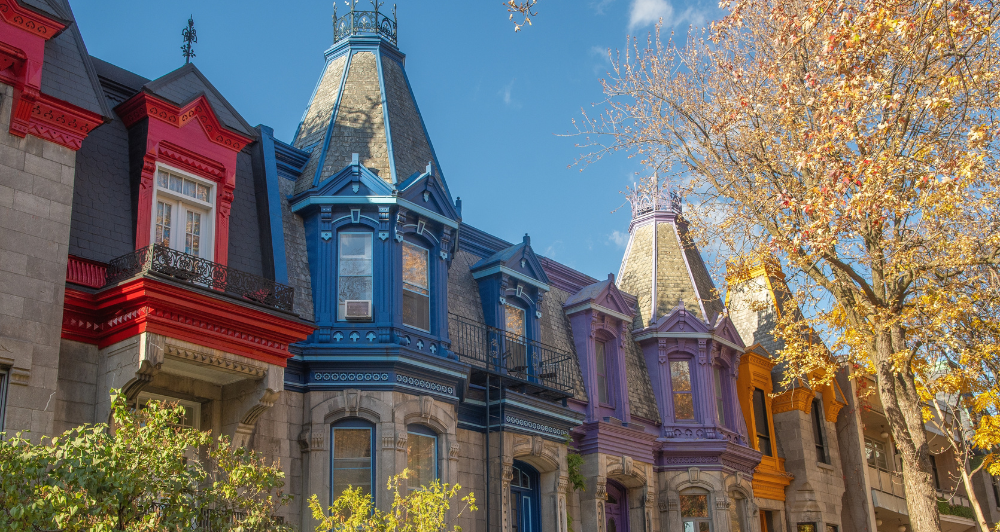
As with much of Eastern Canada, Montreal is also a city that is best tasted, and the markets are part of the city’s rhythm. Jean-Talon is the big one, a sprawl of stalls selling seasonal produce, Québec cheeses, and just about anything locals might need to pick up for dinner. Atwater is smaller and set by the river, and has that lovely intimate feel often only found in old neighbourhoods.
Montréal is also a city that knows how to eat, so you’ll find everything from legendary bistros favoured by natives to cutting-edge Michelin stars that attract foodies and fleeting visitors alike. Classicists should book L’Express – a bistro that’s been doing steak frites and late-night plates for decades (always a great sign). For something a little more contemporary, try Mon Lapin in Little Italy. It's personal, it’s inventive (the menu has featured scallop sandwiches and layered buckwheat cakes), and their wine list is one of the most exciting in the country.
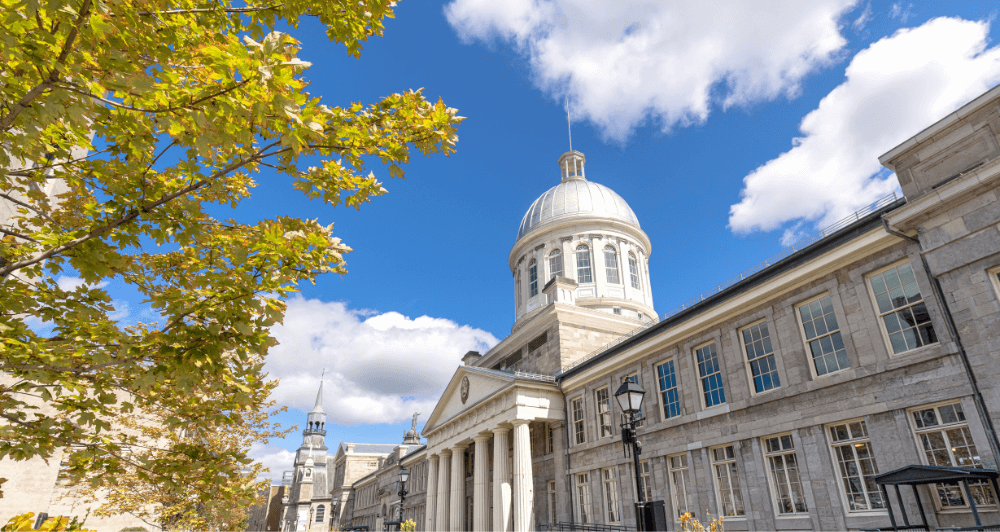
If you can, one final thing to consider is timing your trip to coincide with one of the city’s festivals – they offer an exciting glimpse into the culture that resides here year-round. Summer’s Jazz Festival (usually late June-July) turns whole streets into open-air stages, and in winter, Montréal en Lumière (late February-March) illuminates the city with food stalls, performances, and outdoor parties – proof that Montréal refuses to hibernate, even when the temperature drops well below zero.
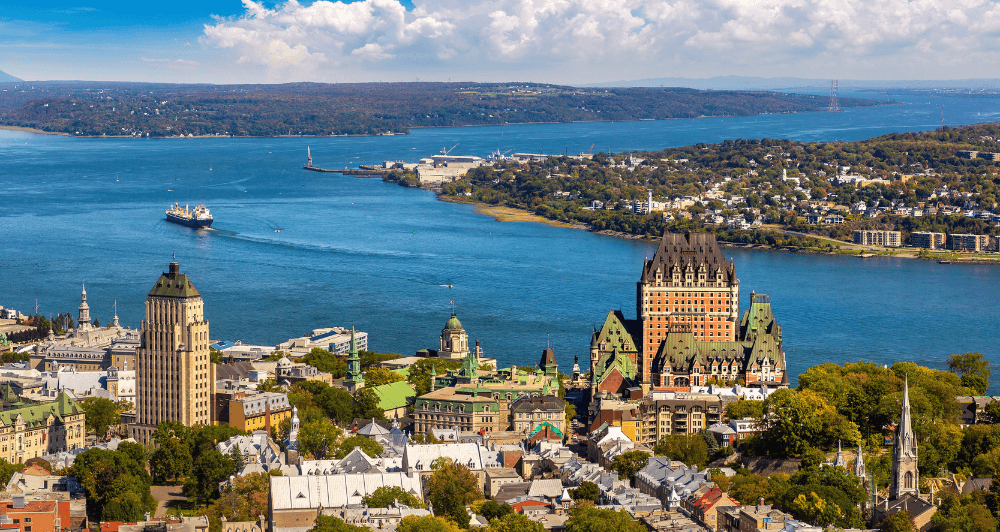
Québec City – History with a Storybook Backdrop
Driving or flying into Quebec City can feel like stepping into another world, or it can feel like stepping into a smaller, more quaint city that retains that charming, European atmosphere. With its fortified Old Town overlooking the St. Lawrence River, it’s the closest North America comes to medieval Europe, and it’s the best stop for anyone interested in history, French Canadian culture, and a more relaxed and walkable city experience.
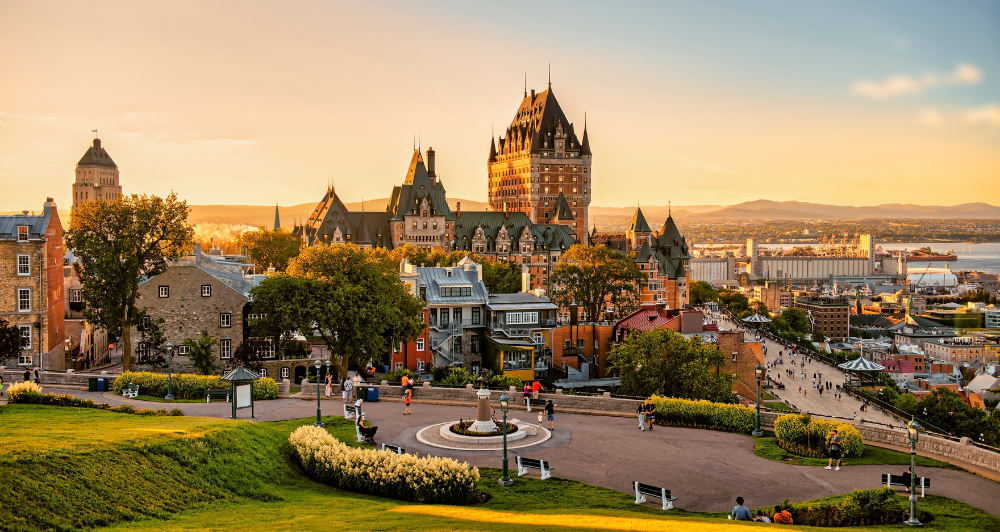
At the heart of it all is Fairmont Le Château Frontenac – an icon that crowns the skyline with its 1890s turrets and spires. Even if you’re not staying here, it’s worth booking in for afternoon tea in Place Dufferin: LOT 35 teas, delicate open sandwiches, freshly baked scones with Devonshire cream and homemade jams, and a side of St. Lawrence River views. It’s indulgent, yes, but it’s also a piece of theatre. One that comes complete with white linen and properly polished service.
After such decadence, you might need a walk through Quartier Petit Champlain. It’s one of North America’s oldest shopping streets, packed full of boutiques and craft shops and bistros that spill onto the walkways. On certain nights of the year the neighbourhood hosts art and theatre nights, and, come Christmas, the streets twinkle with lights and feel impossibly charming. Private walking tours of the ramparts and La Citadelle can add colour to the history (and help you to walk off the sugar high offered in the Fairmont), as tales of colonial skirmishes and centuries-old defences are brought to life.
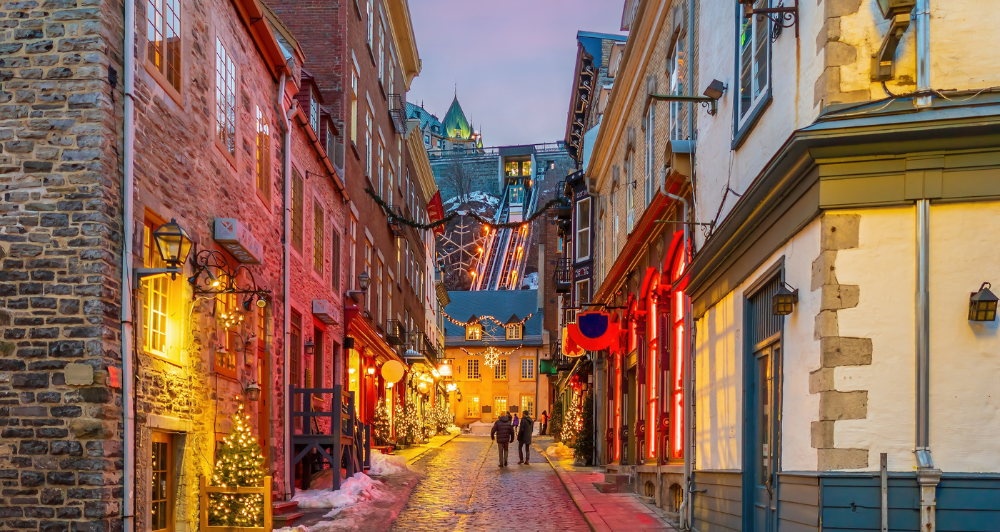
There’s a theme with dining in Eastern Canada, as it’s no less spectacular in Quebec City than in any other French-speaking province. Tucked into 17th-century vaults, Tanière³ is the one to book if you’re serious about food – an avant-garde tasting menu that makes an artful nod to the region’s natural bounty. Intimate, theatrical, and highly sought after, it’s worth booking months ahead.
If you’re planning to visit in the summer (which aligns with the British season) is the Festival d’été de Québec. It’s Canada’s largest musical festival, and it transforms the Plains of Abraham into a lively concert stage that hosts everything from rock acts to orchestras. In winter, the Carnaval de Québec takes over with ice sculptures, magical night parades and evenings of parties. Locals bundle up prove that snow is just another excuse to celebrate Nordic culture.
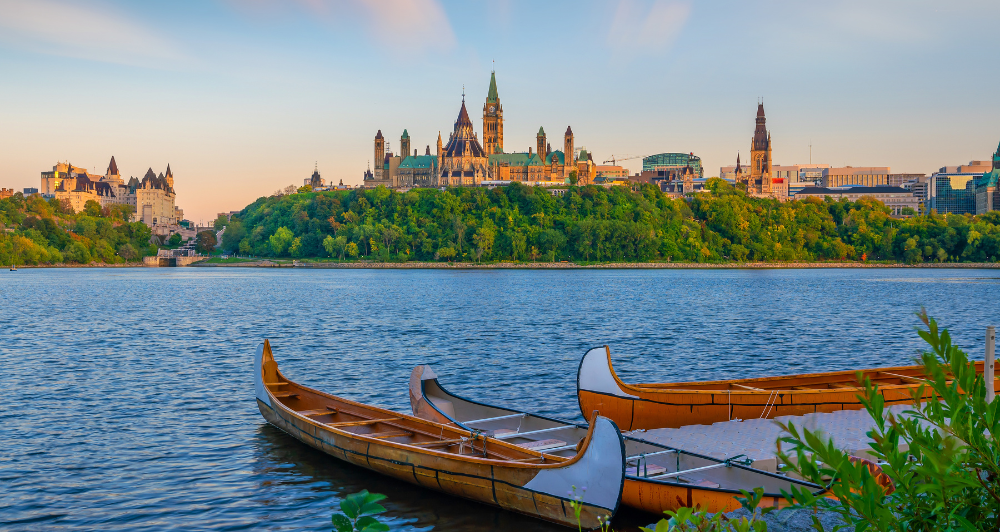
Ottawa – Canada’s Quiet Capital
Ottawa quiet style and ceremony is exactly what makes it so attractive and enticing. It’s the capital of Canada, but it’s also green, spacious, and surprisingly easy-going.
The best explorations of the city begin with Parliament Hill. Guided tours run for about half an hour and give you both the history and the politics – and the Gothic Revival architecture alone is worth the walk. From there, it’s a 5-minute walk cross the Rideau Canal (a UNESCO World Heritage site) to ByWard Market. Here, artisan shops, farmers’ market stalls, speciality food stands, and cafés blur the line between tourist favourite and local hangout spot. Don’t miss the maple-infused chocolate – cliché or not, it’s delicious.
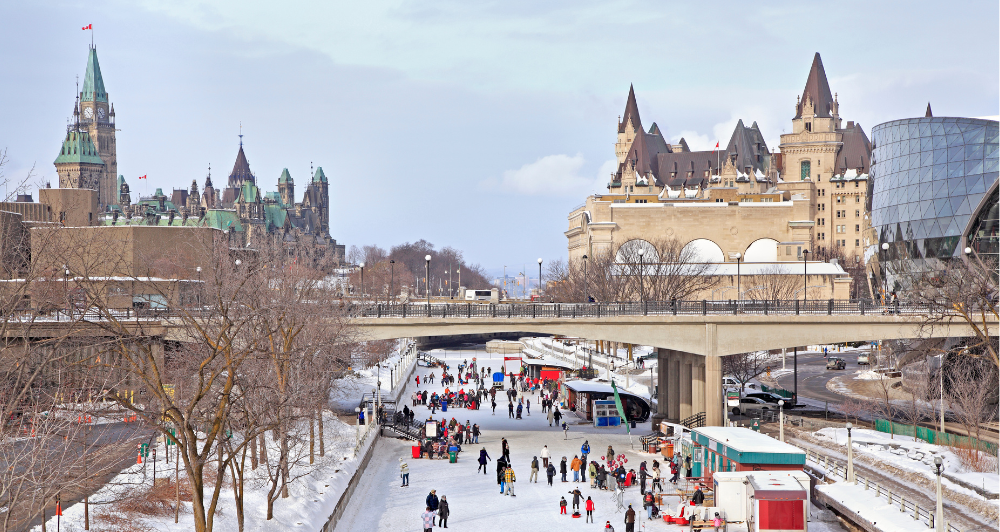
In summer, hop on an electric boat trip along the Rideau Canal to see the city from the water. If you choose a guided trip you’ll learn about the waterway’s over 200-year-old history as you go. In winter, the very same canal freezes into the world’s largest skating rink – almost five miles of pure Canadian fun that winds right through the heart of the capital.
For art lovers, the National Gallery of Canada is an essential visit. Its collection spans Indigenous works, European masters, and contemporary pieces, including Louise Bourgeois’ enormous spider “Maman” standing guard outside. Tours are just a few dollars extra and make the vast collection much easier to navigate.
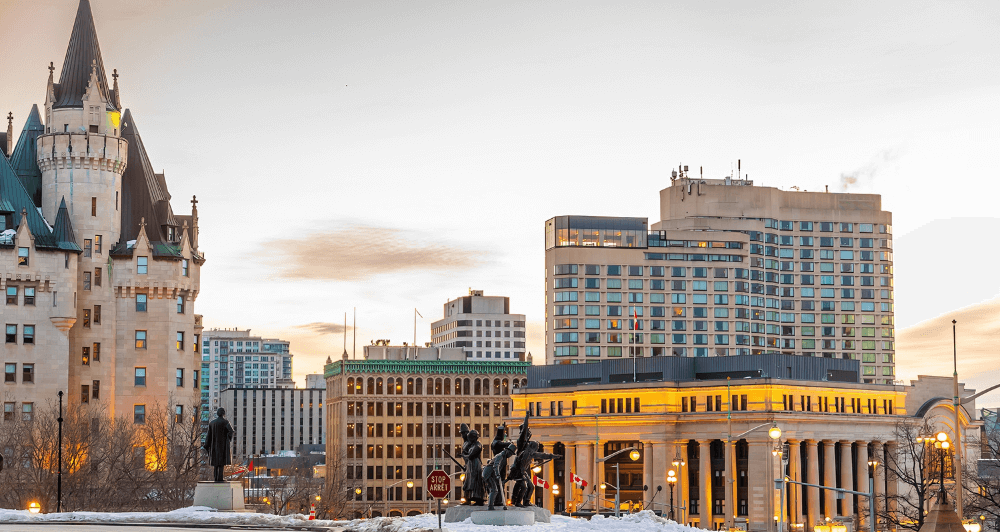
During your time in Ottawa, we recommend staying at the Fairmont Château Laurier. A grand Edwardian pile set between Parliament Hill and ByWard Market, it’s all sweeping staircases, chandeliers and just the right amount of old-world drama inside – very fitting for a capital city that does tradition so well.
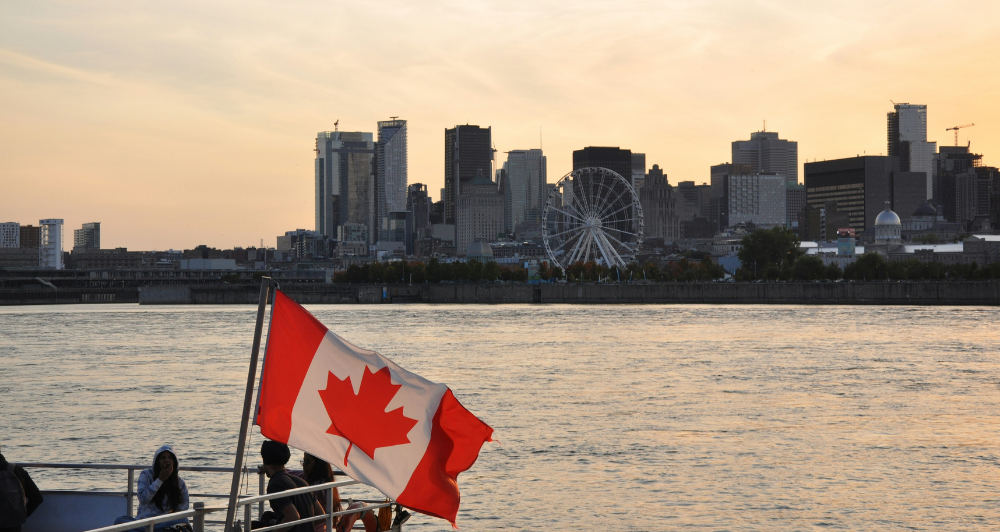
Four Cities, Four Characters
String Toronto, Montréal, Québec City and Ottawa together and you’ll get an Eastern Canada trip that never settles into one distinct mood. Toronto is sleek, modern and high-paced, Montréal is atmospheric, European, and boldly Canadian at the same time, Québec City is history and romance dressed as theatre, and Ottawa adds a touch of national gravitas, a city where politics and heritage share the stage.
With Destinology, we will shape the journey to match your pace – whether that’s scenic train rides between Montréal and Toronto, a private driver for seamless transfers, or a self-drive route for total freedom. However you move between them, the story remains the same: four cities, each with its own way of pulling you in. In our opinion, Eastern Canada is best savoured slowly, with a touch of curiosity and, ideally, a little Destinology indulgence along the way.
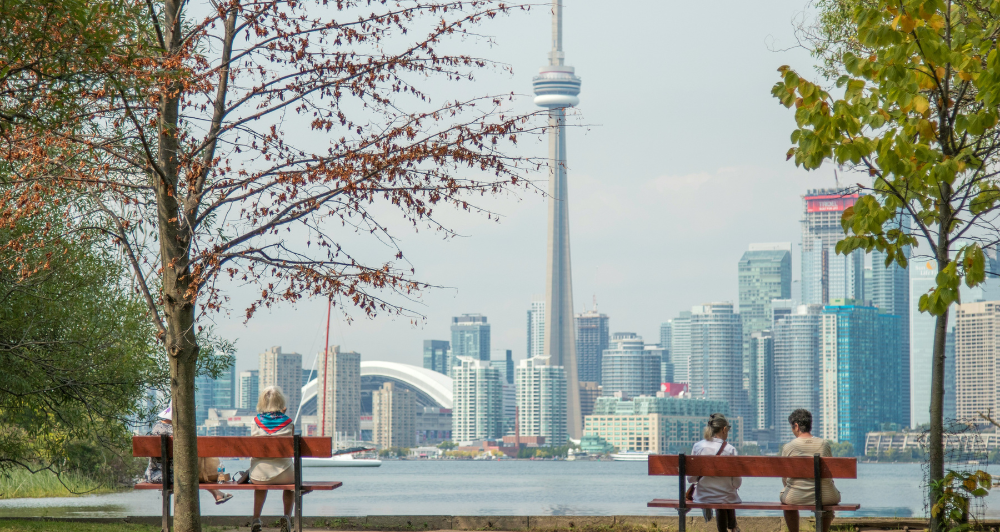
Eastern Canada Ticklist – Our Must-Sees
Toronto
CN Tower – iconic skyline views and dinner at the 360 Restaurant if you want to add a little theatre.
Kensington Market – vintage shops, global street food, and walls of graffiti.
Distillery District – cobblestone streets, Victorian warehouses now filled with cocktail bars, galleries, and indie shops.
Yorkville – designer boutiques, modern galleries, and people-watching over coffee.
Restaurant 20 Victoria – an intimate and seafood-driven tasting menu.
Alo – Canada’s most talked-about fine dining. Always a surprise menu.
Helicopter to Niagara Falls – dramatic views with the option of a wine tasting in the Niagara Peninsula.
Montréal
Old Montréal – cobbled lanes, limestone façades, and Notre-Dame Basilica.
Crew Collective & Café – a café in a grand old bank, vaulted ceilings and marble columns intact.
Jean-Talon Market – the city’s foodie heart, full of Québec cheeses, fresh produce and spice stalls.
Atwater Market – smaller, riverside, and with a proper neighbourhood feel.
L’Express – the legendary bistro, open until the early hours.
Mon Lapin – playful plates and one of Canada’s best natural wine lists.
Jazz Festival (summer) – the world’s biggest jazz gathering.
Montréal en Lumière (winter) – food, light and outdoor fun in the depths of February.
Québec City
Fairmont Le Château Frontenac – a skyline icon, where afternoon tea is a ritual.
Quartier Petit Champlain – one of North America’s oldest shopping streets, with boutiques and festive lights at Christmas.
The Ramparts & La Citadelle – explore the city’s colonial past on foot with a private guide.
Tanière³ – an avant-garde tasting menu served in 17th-century vaults.
Festival d’été de Québec (July) – Canada’s largest music festival on the Plains of Abraham.
Carnaval de Québec (February) – snow sculptures, night parades and winter celebrations since 1955.
Ottawa
Parliament Hill – guided tours through Canada’s political heart.
ByWard Market – artisan shops, food stalls, and a chance to sample maple-infused chocolate.
Rideau Canal – boat cruises in summer, the world’s largest skating rink in winter.
National Gallery of Canada – Indigenous works, European masters, and Louise Bourgeois’ giant spider sculpture 'Maman'.
Fairmont Château Laurier – the city’s grande dame hotel, perfectly placed between Parliament Hill and the market.
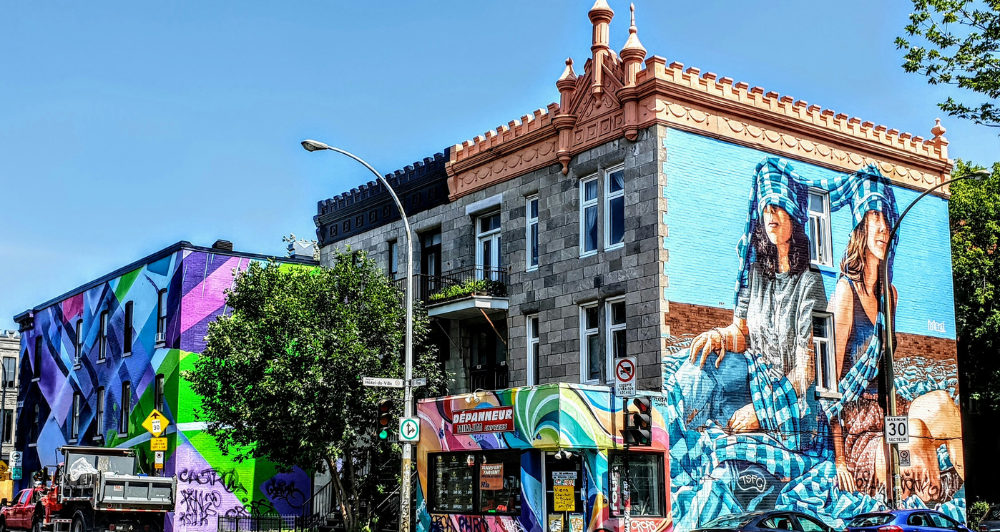
Eastern Canada & General Travel
FAQs
What currency is used in Eastern Canada, and do I need cash?
Canada uses the Canadian Dollar (CAD). As with the United Kingdom, credit and debit cards are widely accepted and cash machines are everywhere. Even so, keeping a little cash (perhaps a maximum of CA$100) is good for small purchases or any rural stops.
Do I need a visa or eTA to visit Eastern Canada?
If you’re visa-exempt (UK, EU, Australia, etc.), you’ll need an Electronic Travel Authorization (eTA) for flying in. It’s around CA$7, very easy to apply for, and it’s usually approved in minutes – at maximum, a few days. Just don’t leave it to the last minute!
What’s the best time to visit Eastern Canada?
Summer (June–September): The summer is perfect for cities, sightseeing, and long days to fill. For ocean-loving adventurers, this is also prime for whale watching and exploring coastal parks.
- Autumn (September–October): Autumn foliage is in full swing - especially in Quebec and Ontario - which makes for those archetypal Canadian views and fewer crowds.
How easy is it to travel between destinations in Eastern Canada?
In the cities, buses, subways, and trains (like VIA Rail) make life and getting around very easy. Renting a car is the best move if you’re heading into rural Eastern Canada - like Maritimes or national parks - where public transport can be a little more sparse.
What languages are spoken in Eastern Canada?
Canada has two official languages: English and French. Québec is predominantly French, with bilingual signage and locals who are generally fluent in both. A few French phrases (merci - thank you, s’il vous plaît - please) go a long way.
Should I bring plug adapters and care about volts in Eastern Canada?
Yes. Canada uses 120 V / 60 Hz and Type A/B plugs (two flat prongs, sometimes with a grounding pin). European travellers will need both a plug adapter and possibly a voltage converter, depending on the device you wish to use.
Do I need to tip in Eastern Canada?
As with much of America, tipping is customary. In restaurants it is normal to tip around 15-20% before tax.
